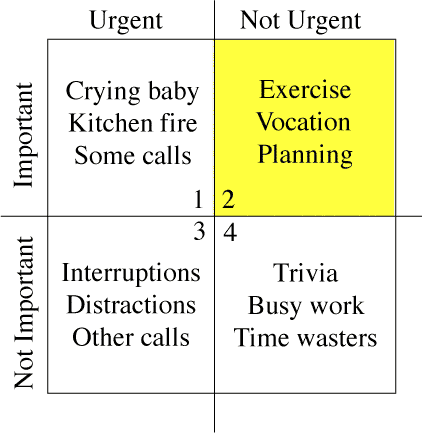Search |
Study Skill: Time Management
1) Creating an environment conducive to effectiveness 2) Setting of priorities 3) Carrying out activity around those priorities 4) The related process of reduction of time spent on non-priorities
Creating an environment conducive to effectiveness Creating an effective time management environment consist of both mental and physical actions. Get organized – Clear up all the clutter in your space and keep it neat. Have a place for everything and make sure you return items to their place when you are done using them. Create organized piles of paper and bind them together with a paper clip or a paper weight. Label the piles with a post it note so that you quickly know where everything is. Take care of yourself – Eat right, sleep right and find methods of rest and relaxing that you enjoy. In order to manage your time you need to be focused. Adequate sleep, a healthy diet and the reduction of stress will all improve your focus. Prepare mentally – There are many psychological factors that contribute to effective time management. Find ways to personally stay motivated and address any underlying issues that may be leading to procrastination. Protect your time – Be able to say no to requests from others for your time on unrelated tasks. Utilize skills such as insulation and isolation by having a defined space where you will be undisturbed and setting regular hours for study and task management. Learn to delegate tasks to others without micro-managing.
Setting of priorities Setting your priorities will involve utilizing your analytical skills. First determine what your overall goals are. Once you have determined what you intend to achieve find out what major steps you need to take reach those goals. Then break down those steps into daily activities.
Carrying out activity around those priorities After determining the steps needed to reach your goal. Begin implementing your daily activities. Utilize tools such as to do lists or day planners to help keep you on task. When creating your daily to do list, it is often advised to start your day with the hardest and most important tasks, so that you have the most time and energy to complete it. It is also important to make sure that you include fun things on your to do list, so you have something to look forward to. One thing to note is, you should be careful not to spend too much time organizing your to do list than is necessary. There are several other strategies to help you determine what order you should handle tasks. ABC Analysis A – Tasks that are perceived as being urgent and important B – Tasks that are important but not urgent C – Tasks that are neither urgent nor important. (This list could also include tasks that are urgent but not important) Pareto Analysis This is the idea that 80% of tasks can be completed in 20% of the disposable time. The remaining 20% of tasks will take up 80% of the time. This principle is used to sort tasks into two parts. According to this form of Pareto analysis it is recommended that tasks that fall into the first category be assigned a higher priority. The Eisenhower Method All tasks are evaluated using the criteria important/unimportant and urgent/not urgent and put in according quadrants. Tasks in unimportant/not urgent quadrants are dropped, tasks in important/urgent quadrants are done immediately and personally, tasks in unimportant/urgent quadrants are delegated and tasks in important/not urgent quadrants get an end date and are done personally.
Time Management Matrix - Merrill and Covey
The related process of reduction of time spent on non-priorities Reducing your time spent on non-priorities will incorporate a blend of items mentioned already. Including protecting your time through insulation, isolation and delegation and addressing underlying psychological factors contributing to procrastination.
References:
|
